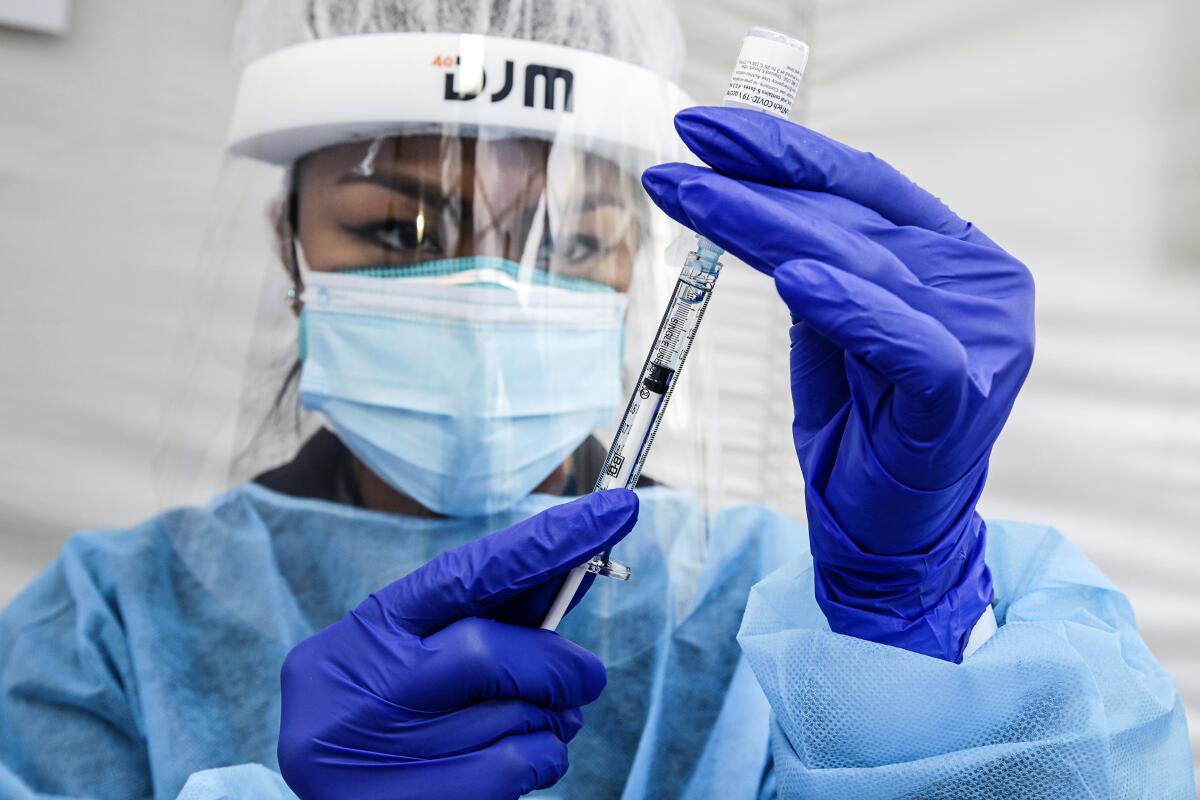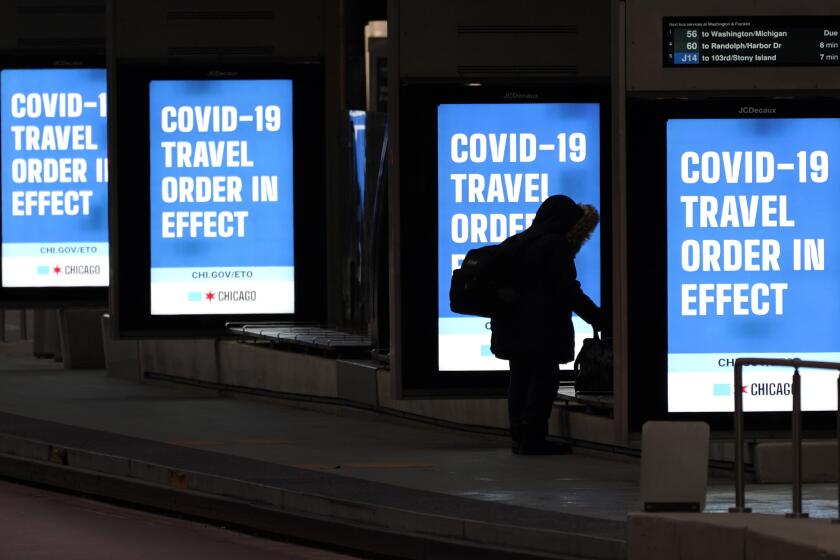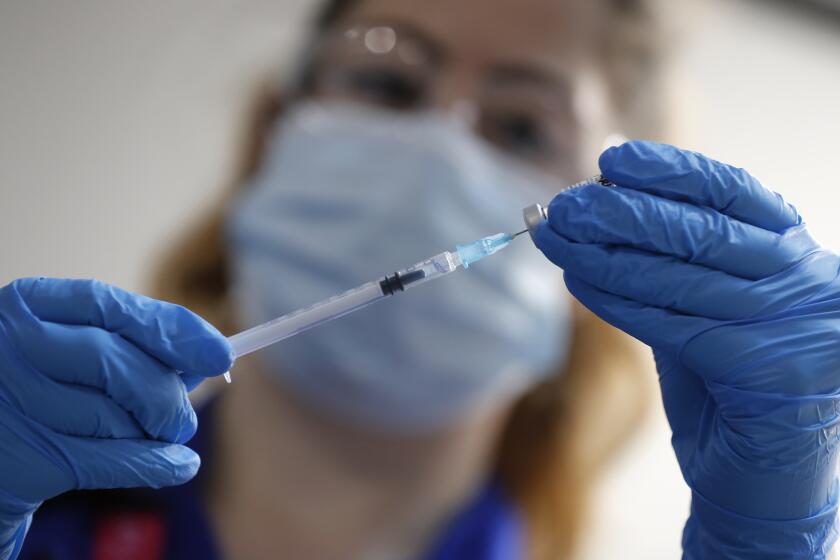U.K. variant of the coronavirus spreads in California, sparking new concern

- Share via
Even as coronavirus cases are going down, officials are expressing growing concern about the dominance of a variant first identified in Britain that is believed to be 50% more transmissible than the conventional variety.
Officials predict the B.1.1.7 variant will become the dominant coronavirus nationwide by the end of March. There are at least 693 cases in 33 states, with the highest numbers in Florida (201) and California (153).
The U.K. variant has been identified in San Diego, Los Angeles, Orange, San Bernardino, Alameda, San Mateo and Yolo counties.
L.A. County officials Monday confirmed the fourth and fifth cases of the B.1.1.7 variant. Public Health Director Barbara Ferrer said it’s clear that there’s a fair number of mutant strains circulating in L.A. County.
If we have a more infectious virus, Ferrer said, “it just makes it easier for people to get infected ... The variants are concerning, because if we let our guard down, the more infectious strains can become dominant. And that just makes it a lot easier for this virus to spread.”
Orange County on Monday confirmed its first case of the U.K. variant in a resident who reported no international travel history, “which means there are likely more cases in OC,” the Health Care Agency tweeted. Officials on Monday also confirmed the first case of the U.K. variant in the Sacramento region — in Yolo County, west of Sacramento — after an individual was determined to have the strain and “may have acquired the variant through travel outside the community,” according to a statement issued by UC Davis and the city of Davis.
At least 138 cases of the U.K. variant have been confirmed in San Diego County, with 50 probable cases there. A UC San Diego scientist has warned government officials that the U.K. strain is so transmissible that its spread — combined with the rejection of mask use and physical distancing guidelines, as occurred across California in the fall — could result in an even worse surge within two months than occurred in the winter.
British scientists have bolstered their case that the new coronavirus variant spreads more easily than its predecessors. It could be worse in the U.S., they warn.
The currently available vaccines are believed to be highly effective against both the conventional variety of the coronavirus and the U.K. strain. There is, however, concern about diminished effectiveness of the current vaccines against a strain first identified in South Africa, B.1.351, which has been identified in six people in three states — Maryland, South Carolina and Virginia.
Officials and scientists are working on a booster shot, if needed, that could be useful against new variants.
Neither the South African variant nor a closely related variant first identified in Brazil, P.1, have been identified thus far in California. The P.1 variant has been identified in two people in Minnesota and one person in Oklahoma.
Another Brazilian variant, known as P.2, has been identified in California at Stanford’s Clinical Virology Laboratory, according to Dr. Benjamin Pinsky, the laboratory’s medical director. The P.2 variant is distinct from the P.1 variant also detected in Brazil that was linked to an abrupt resurgence in cases in Manaus, the largest city in the Amazon region, that took place after much of the population was already believed to have been infected.
Both Brazilian variants share a mutation that appears to help the virus evade antibodies generated by either a previous infection or a vaccine. There are at least two examples of people being infected with the P.2 variant after they had been infected by another strain, a feat that has been demonstrated by P.1 and multiple other coronavirus strains. That finding has led researchers to theorize that P.2 may have similar properties as the P.1 variant, he said.
A coronavirus variant from Brazil has been detected in a sample from the Bay Area, underscoring the urgency of ramping up inoculation efforts
In California, officials have identified more than 1,200 cases of a pair of so-called West Coast variants, B.1.427 and B.1.429, that have comprised a significant share of genomically sequenced virus samples analyzed in California in recent months. Scientists are reviewing whether the West Coast variants are more transmissible than the regular variety of the coronavirus. The West Coast variants have since been detected in at least 25 other states.
“The continued proliferation of variants remains of grave concern and is a threat that could reverse the recent positive trends we are seeing,” Dr. Rochelle Walensky, the director of the U.S. Centers for Disease Control and Prevention, said Monday at a news conference of the White House COVID-19 Response Team.
She urged people to continue wearing masks and staying six feet apart from people outside your household. “Avoid travels, crowds and poorly ventilated spaces. And get vaccinated when it’s available to you,” Walensky said.
A travel advisory remains in effect in L.A. County, recommending against any nonessential travel 120 miles outside the county, especially for travel considered tourism or recreational in nature. Anyone arriving in L.A. County from other states or countries for non-essential travel must self-quarantine for 10 days after arrival.
“Our progress can easily be undone, and it takes less than 15 minutes of exposure to someone with COVID for someone to get sick themselves,” L.A. County Supervisor Hilda Solis said.
With the critical shortage of vaccines, there has been considerable public discussion about whether officials should begin to try to vaccinate as many people as possible with the first dose, rather than ensuring one-time administration of second doses, which are given three or four weeks after the first shot, depending on the brand.
Dr. Anthony Fauci, the U.S. government’s top infectious-diseases expert, said delaying the second dose for too long on a widespread scale could actually invite more problematic mutants to arise.
“We feel the optimum approach would be to continue with getting as many people on their first dose as possible, but also making sure that people — on time — get their second dose,” Fauci said.
Researchers once believed t would take months or even years for the virus to develop resistance to vaccines. The speedy evolution is largely a result of the virus’ unchecked spread.
Officials have also said they expect vaccine shortages to ease in the coming months, with the likely introduction of a vaccine manufactured by Johnson & Johnson in March, which requires only a single dose and is easier to manufacture than the two-dose inoculations made by Pfizer and Moderna.
It will probably take a couple of weeks before it becomes clear if there is a bump in coronavirus cases because of gatherings held on Super Bowl Sunday. But so far, trends are continuing to improve.
As of Monday, the average number of coronavirus cases reported in California over the past week was about 13,000 a day, a 70% decrease from the average number for the week that ended Jan. 10, when California was recording nearly 45,000 cases a day. Still, the number of daily cases is substantially worse than it was in early October, when California was recording about 3,000 coronavirus cases a day.
COVID-19 hospitalizations are also down from a high of nearly 22,000 in California to about 11,000 as of Sunday, although that number is still far worse than the roughly 2,000 hospitalized COVID-19 patients in early October.
Hospitals in L.A. County still remain very crowded and still have limited available capacity in the intensive care units. But California lifted its order prohibiting nonessential surgeries and procedures in the hardest hit counties late last week, and in L.A. County, crowding in emergency rooms has eased, L.A. County Health Services Director Dr. Christina Ghaly said Monday.
The percentage of coronavirus test results coming back positive in California has fallen from a winter high of 14%, recorded for the seven-day period that ended Jan. 7, down to about 5% for the weekly period that ended Monday. That’s the lowest figure since mid-November but still double the amount from the first week of October, when the positivity rate was 2.42%.
Average daily COVID-19 deaths still remain high in California, but appear to be trending downward. The peak occurred over a seven-day period that ended Jan. 27, when California was averaging 562 COVID-19 deaths a day; by Monday, that number had fallen to 450 deaths a day. In early October, California was averaging about 75 COVID-19 deaths a day.
California has cumulatively reported about 3.4 million coronavirus cases and more than 44,400 COVID-19 deaths. On a per capita basis, with about 113 deaths per 100,000 residents, California has the 34th highest cumulative death rate of the 50 states, the District of Columbia and Puerto Rico.
The 10 states with the highest cumulative COVID-19 death rates are New Jersey (248 deaths per 100,000 residents), New York (229), Massachusetts (220), Mississippi (210), Rhode Island (209), South Dakota (209), Arizona (202), Connecticut (201), Louisiana (196) and North Dakota (193).
According to The Times’ COVID-19 vaccination tracker, 9.6% of Californians have received at least one dose of vaccine. Over the last seven days, about 175,000 doses per day have been administered across California; that’s double the rate from mid-January.
Scientists thought the U.K. variant was more transmissible, but evidence suggests those who have the virus are also more likely to die from it, Dr. Anthony Fauci says.
Dr. Ashish Jha, dean of the Brown University School of Public Health, sounded the alarm about the rise of the U.K. variant over the weekend because of how much more contagious it is, saying on Twitter on Sunday, “It can quickly overwhelm a nation.”
He noted that the U.K. strain in Ireland was starting to circulate in mid-December and within three weeks, the number of new coronavirus cases more than quadrupled, and Ireland went into what he called a full lockdown by the end of December. “Our holiday ‘surge’ was small in comparison,” Jha said.
“Most public health experts expect a spike from B.1.1.7,” Jha tweeted. “We need to act very quickly if we see infections starting to inch up.”
He cited a study that has not yet been peer reviewed, coauthored by scientists at the Scripps Research Institute in La Jolla, UC San Francisco, UC San Diego and UCLA, that found the U.K. strain entered the U.S. as early as November, “with onward community transmission enabling the variant spread to at least 30 states as of January.” It added weight to a CDC forecast that the U.K. strain was on track to be the dominant strain in the U.S. by the end of March.
Times staff writers Sean Greene and Alex Wigglesworth contributed to this report.
More to Read
Sign up for Essential California
The most important California stories and recommendations in your inbox every morning.
You may occasionally receive promotional content from the Los Angeles Times.
















